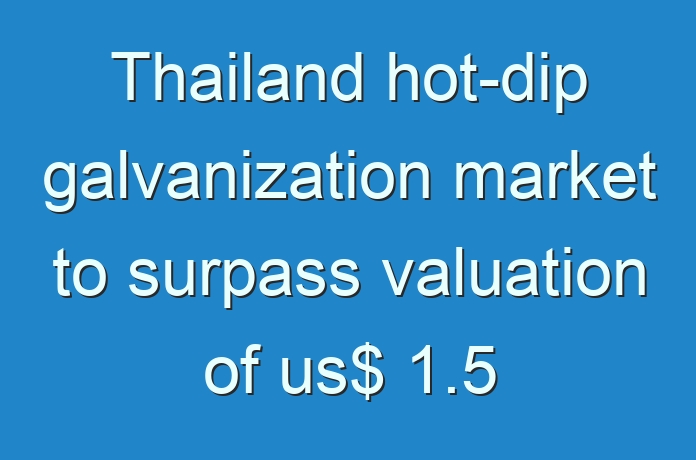
Thailand Hot-dip Galvanization Market: Introduction
The hot-dip galvanization market in Thailand was valued at US$ 900 Mn in 2019. It is anticipated to expand at a CAGR of ~5% from 2020 to 2030. The construction industry in Thailand is expanding and fueling the demand for hot-dip galvanized metals that can resist corrosive environment. This, in turn, is propelling the hot-dip galvanization market.
Key Drivers of Thailand Hot-dip Galvanization Market
Currently, Thailand is the 13th largest exporter of automotive parts and the sixth largest manufacturer of commercial vehicles in the world. It is the largest among ASEAN countries. According to a study conducted by the International Energy Agency, the number of EVs globally is projected to rise to account for 35% of all vehicles by 2040. On the other hand, in Thailand, the popularity of EVs are still low; however, hybrid electric vehicles (HEVs) have been launched since around 2010. According to statistics from the Land Transport Department of Thailand, the number of registered HEVs and plug-in hybrid electric vehicles (PHEVs) were at 84,236 units, while only 63 units were battery electric vehicles (BEVs). This is projected to increase the usage of hot-dip galvanized products in the near future.
Hot-dip galvanization is extensively utilized to protect the underlying metal from rust. The increase in production of new electric vehicles in the near future is estimated to boost the demand for hot-dip galvanized metal in the long-term for its usage in the production of automotive exteriors or body parts.
Request a Sample-
https://www.transparencymarketresearch.com/sample/sample.php?flag=S&rep_id=78939
Possible Threats Restricting Thailand Hot-dip Galvanization Market
In terms of quality, hot-dip galvanization (HDG) provides 10 times more corrosion resistance as compared to that offered by electro-galvanization. However, hot-dip galvanization usually is 5 times more expensive than electro-galvanization. Hence, a moderate threat from substitute technology exists, which offers significant opportunities for hot-dip galvanization processors.
Key Opportunities in Thailand Hot-dip Galvanization Market
According to a survey conducted by American Chamber of Commerce, in May 2019, 40% of U.S.-based companies are planning to relocate or have already relocated their manufacturing facilities outside China. Several importers are planning to procure auto components and other manufactured goods from other countries in Asia, such as Thailand, Vietnam, and India, due to recent economic and political developments. Thus, providing an opportunity for domestic hot-dip galvanizers to establish a strong presence by increasing their capacity. The U.S.-China trade war has diminished China’s cost advantage, owing to increased tariffs imposed by the U.S. and several other countries such as India and Japan. Minimum wages in China have almost doubled from 2009 to 2014, making it only 4% cheaper than the manufacturing labor cost in the U.S.
Thailand can act as an alternative manufacturing option to China. For instance, Sony Corporation moved its production to Thailand and closed its smartphone plant in Beijing, China in a bid to cut costs and boost smartphone business revenues. According to National Economic & Social Development Council, Thailand, 10 firms, including Sony, Sharp Corporation, Harley-Davidson Inc. and Delta Electronics Inc. are in the process of relocating their operations to the Eastern Economic Corridor development zone on the east coast of Thailand from China. The Government of Thailand is planning to upgrade its three main manufacturing cities: Chonburi, Rayong, and Chachoengsao, under its US$ 45 Bn plan of Eastern Economic Corridor, in order to boost its manufacturing industries. The expansion and establishment of the manufacturing industry is estimated to boost the demand for hot-dip galvanized steel and other metal products in their construction activities.
Request for covid19 impact analysis –
https://www.transparencymarketresearch.com/sample/sample.php?flag=covid19&rep_id=78939
Recently, on August 2020, the Government of Thailand has imposed 35.67% anti-dumping duties on targeting china-origin hot-dipped galvanized (HDG) coils and sheets that can negatively impact steel exports from China and is estimated to boost domestic manufacturing of hot-dip galvanization. This strategic initiatives taken by the Government of Thailand can enhance the production of manufactured goods such as hot-dip galvanized steel and further boost steel exports. Existing players in the hot-dip galvanization market are well-established and can benefit from the ongoing trade war to enhance sales.
Share of Prominent Players in Thailand Hot-dip Galvanization Market
Key players operating in the hot-dip galvanization market in Thailand are POSCO Coated Steel (Thailand) Co. Ltd, NS-Siam United Steel Co. Ltd. and JFE Steel Galvanizing (Thailand) Ltd., BJC Heavy Industries PCL, Thai Scandic Steel Co. Ltd., and Ajikawa & SCI Metal Tech Co. Ltd. Both POSCO Coated Steel (Thailand) Co. Ltd and JFE Steel Galvanizing (Thailand) Ltd. hold more than 20% share of the hot-dip galvanization market in Thailand in 2019.
Thailand Hot-dip Galvanization Market: Segmentation
Thailand Hot-dip Galvanization Market, by Furnace Type
- Ceramic
- Steel Kettle
- Hybrid Robots
Thailand Hot-dip Galvanization Market, by Metal Type
- Steel
- Iron
- Aluminum
- Others
Thailand Hot-dip Galvanization Market, by End-use Industry
- Building & Construction
- Automotive
- Electrical & Electronics
- Others
Buy now-
https://www.transparencymarketresearch.com/checkout.php?rep_id=78939<ype=S
Companies in the Thailand Hot-dip Galvanization market have increasingly shifted gears with wide application of digital technology across the continuum, from raw material sourcing to manufacturing to generation of final output, to warehousing to final distribution operations. Among the various affects, the market is witnessing new growth economics due to thinning of line between specialty and commodity businesses that are associated with the larger ecosystem. At the same time, new growth parameters are being vigorously being debated as industry stakeholders put greater emphasis on the circular economy processes.
More Trending Report-





